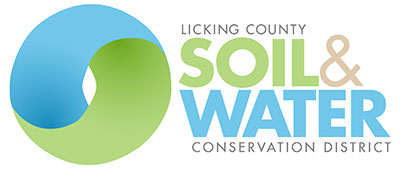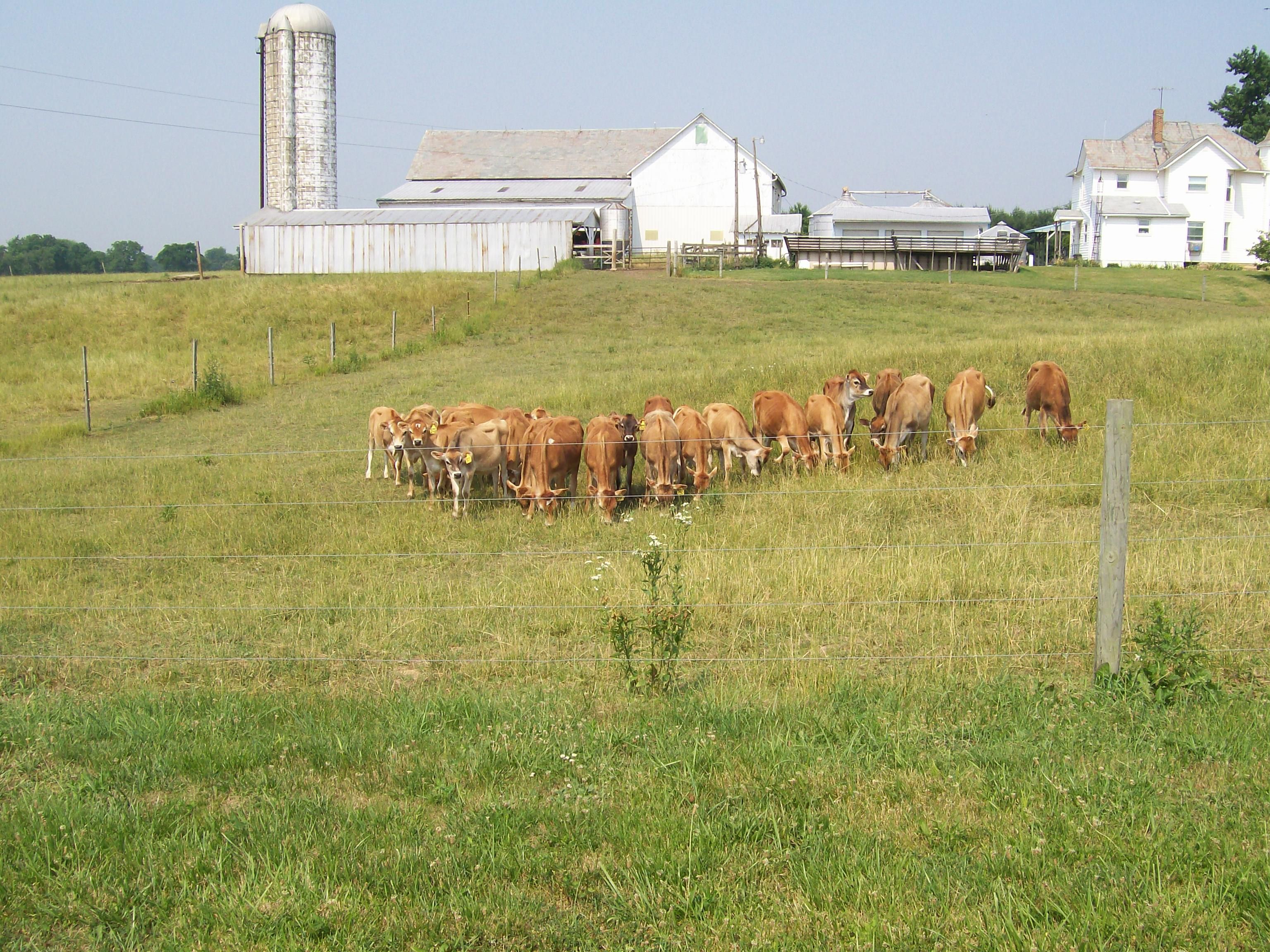What is a Conservation District?
Conservation Districts are locally-organized, self-governing bodies chartered by the State. Through voluntary action and cooperation of landowners and other stakeholders, we work to conserve land, soil, water, forest, wildlife and other related resources for the benefit of all.
Mission: To promote conservation of natural resources through local leadership, education and technical assistance.
History of Licking County Soil & Water

Since 1944, Licking County Soil & Water Conservation District exists to promote wise use of our land and water. During those 80 years, Licking Soil & Water has worked with countless landowners to manage and protect natural resources on public and private lands. This year, for our 80th birthday, Licking Soil & Water is reflecting on our history in and impact on Licking County.
1930-1940's
Do you remember reading John Steinbeck’s The Grapes of Wrath? Those “Okies” were leaving Oklahoma after drought, the Great Depression of the 1930s, and collapse of the tenant farmers’ agriculture system. The soil was destroyed to the point of blowing away; this phenomenon was called the Dust Bowl. On May 12, 1934, the worst dust storm in the nation's history swept eastward from the Great Plains to the Atlantic Ocean, obscuring the sun and depositing obvious films of dust as it moved. This catastrophic storm served as the catalyst for public outcry and congressional action for soil and water conservation throughout the nation.
Why did the Dust Bowl happen? Could it be prevented? What can we learn from these mistakes? The federal government tried to answer these questions through the creation of the Soil Conservation Service (SCS) within the US Department of Agriculture (USDA) in 1935. A man named Hugh Hammond Bennett led the fledgling SCS but was not new to soil science. Bennett was convinced that soil was not an exhaustible resource and had been working feverishly to share his opinions with colleagues and land managers since the early 1900s. He co-wrote Soil Erosion: A National Menace in 1928. Over the course of his 16 years with the SCS, Bennett changed the mindset of farmers and politicians toward soil and its conservation practices.
Unfortunately and not surprisingly, the farmers that SCS wanted to work with in 1935 were skeptical of federal involvement. Not much progress was made until the federal government enacted a law establishing a state soil conservation agency and most-importantly, procedures to organize local soil and water conservation districts. In 1941, Ohio created the Ohio Soil Conservation District Enabling Act so local conservation districts could begin to rebuild soil in partnership with the agriculture community.
In 1943, a group of 75 Licking County landowners requested a hearing and petitioned the state for the formation of a local conservation district. Once the Ohio Soil Conservation Committee deemed there to be a sufficient need for the district, the petitioners conducted a local referendum for or against the proposed conservation district. The referendum’s overwhelming support indicated that local people were dedicated to the cause of soil conservation and spoke emphatically at the polls when given the opportunity. Five Supervisors were elected and the Licking County Soil & Water Conservation District officially became a political subdivision of the State of Ohio. E. T. Denman, J. F. Morrison, Clayton Oyler, George Smith, and H. Lee Williams served as the first Board of Supervisors.
Ohio did not suffer from wind erosion like the American Great Plains did during the Dust Bowl, but we did suffer soil damage via water erosion. The solutions, and the processes to adopt and install those solutions, were painful to accept and took courage by all involved. Licking Soil & Water employees and elected Supervisors, as well as farmers served as local conservation professionals who understood local resource issues. The locally-led component of the soil and water conservation district model literally transformed agricultural practices in Licking County.
To reduce soil loss via water erosion, farmers were asked to voluntarily leave crop residue on their fields, to plant with the contours of the land, to build terraces to slow down surface water runoff, and to turn the most fragile areas back to their natural state. To encourage and reward conservation farming, the USDA provided cost-sharing payments for conservation practices. To learn more about how sustainable agriculture was brought to Ohio, click here.
Watch Hugh Hammond Bennett: The Story of America’s Private Lands Conservation Movement below.
The 1950-60's
During the 1950s, 1960s and 1970s Licking County’s population doubled to 120,000. The Board of Supervisors hired paid employees to fully serve the community’s conservation assistance needs.
During the 1950s, the Board of Supervisors received numerous requests for technical assistance from landowners. They helped install contour strips and farm ponds, tree plantings, diversions and drainage enhancements, pasture and forest improvements, and wildlife plantings.
In 1951, Ohio House Bill 161 allowed the Licking County Commissioners to use local monies to fund Licking Soil & Water. Additionally, the bill established the local and state partnership whereby the state matched every dollar the county commissioners allocated to Licking Soil & Water. This unique partnership continues to this day.
The Supervisors established working committees and recruited community members to serve on Program, Finance, Education, Publicity, and Legislative Committees. They began nominating deserving farmers and themselves for conservation awards including the Goodyear Award for soil conservation sponsored by the Goodyear Tire and Rubber Company and the B & O Railroad soil conservation contest.
By 1966, each of Ohio’s 88 counties had their own conservation district, but they lacked a good umbrella agency to tie them together. In 1969, Ohio Senate Bill 160 nested all districts under the Ohio Department of Natural Resources and created the Division of Soil and Water Districts. Conservation education programs grew rapidly during this period and field days hosted by local farmers became social events that folks looked forward to. Topics included Farm Plans, Conservation Days, Forestry, Fishing and Ponds, and Conservation Tours by Air.
In the 1970s, technology on the farm advanced and conservation tillage changed how we planted our fields. No-till, a practice still in use today, promoted less labor, lower fuel costs, less equipment investment and lower tractor horsepower when compared to other farming practices.
Previously, most conservation practices centered on soil, but as rivers became seriously polluted and some literally caught on fire, soil and water conservation districts were a natural group to assist landowners with non-point source pollution management. The Environmental Protection Agency, established in 1970, and the Clean Water Act of 1972, opened a new education opportunity for Licking Soil & Water to begin reaching the entire community. Water quality and soil health concerns were clearly no longer limited to the farm.
The 1970-1990's
Conservation politics and legislative action dominated the 1970s. Although the federal Clean Water Act of 1972 only focused on point source pollution from industry and municipal sources, Licking Soil & Water prepared for the inclusion of non-point source pollution from farms and other land-disturbing operations such as construction sites. In 1971, when the Clean Water Act was still being debated in the US Congress, Ohio Senate Bill 305 committed soil and water conservation districts to administer agriculture pollution and urban sediment pollution programs.
The Agricultural Nonpoint Pollution Abatement Program focused on four types of potential pollutants: agricultural erosion, agricultural chemicals, animal wastes, and air pollution. Licking Soil & Water took a proactive approach and educated landowners with field days and outreach. The tagline keep it under cover! FOR LAND’S SAKE! was used on billboards to promote cover crops in the mid-70s.
The Urban Sediment Pollution Abatement Program’s development was challenging due to diverse voices and concerns of excessive burdens on the construction industry. The intention of pollution abatement was to protect soil and water resources, but additional permit delays and added costs of construction were valid issues that Licking Soil & Water helped to address.
In 1975, Licking Soil & Water led the way in developing a detailed Soil Survey along with the Soil Conservation Service and support from the Licking County Commissioners. This intense undertaking took 10 years of soil scientists walking the county, noting soil types on the 1940 aerial maps and creating the book Soil Survey of Licking County, published in 1985.
Legislation in the 80s impacted Licking Soil & Water’s work and relationships with federal, state and local governments. The 1985 Farm Bill introduced Sod Buster and Swamp Buster provisions, the Conservation Reserve Program (CRP), and the Highly Erodible Lands (HEL) management program.
The 1987 amendments to the federal Clean Water Act set in motion the Municipal Separate Storm Sewer (MS4) program requiring cities to manage stormwater. It also created a federal fund to control nonpoint source pollution called 319. Using 319 funds in the 90s, Licking Soil & Water offered landowners free soil tests. As part of the 319 grant, education efforts promoted the importance of using soil test results to make wise land use decisions.
With additional responsibilities, the Licking Soil & Water team grew. At the beginning of the 70s, Licking Soil & Water employed two people, Gordon Postal, Executive Secretary and Jackie Hunter, Office Secretary. By the end of the 90s, there was a team of 6 conservation professionals led by Jim Kiracofe as District Program Administrator.
2000-2020s: Modern Initiatives and Partnerships
Streambank erosion is not a new issue, but in 2001 Licking Soil & Water took on a serious streambank erosion problem along the North Fork Licking River. By the spring of 2005, with nearly one million dollars in grants and community support, the St. Louisville project was complete. Licking Soil & Water still holds this conservation easement.
Conserving working lands through easements became a larger workload with the Farmland Preservation program’s launch. Licking Soil & Water helped producers place over 30 easements on more than 3,100 acres, with many more farms in process.
We continue to help landowners use conservation practices. To encourage the use of cover crops, Licking Soil & Water joined forces with Muskingum Watershed Conservancy District to offer a cost-share program starting in 2013.
With the County Commissioners support, Licking Soil & Water joined the county’s Technical Review Committee to protect land and water during development. More recently, Licking Soil & Water took on management of a collaborative stormwater permit that focuses on limiting urban pollution
The Power of Partnerships
Local leadership is a tenant of the Licking Soil & Water mission. Multiple supervisors have served on the Ohio Federation of Soil and Water Conservation Districts Board including Charles Warthen and Bill Goodman. In 2006, Licking Soil & Water partnered with the Hartford Fair and various groups to create the Natural Resources Area. Today this beautiful site provides a park-like setting to relax and enjoy free, family-friendly programing.
A few years ago, when the Ohio Certified Volunteer Naturalists of Licking County were in need of a new host agency, we joined forces with the Licking Park District and The Dawes Arboretum to adopt this group of educated and dedicated naturalists.
In 2011, the City of Newark and Licking Soil & Water resurrected the River Round Up. Today it is a premier river cleanup event. The
tremendous expansion is directly tied to recruiting partners and developing a robust planning committee.
Looking Forward to Another 80 Years
Wise use of land and water today is an investment in future generations. Soil & Water is proactively benchmarking the natural resources in the county as we experience unprecedented growth and land use changes.
Currently we are managing a total of 9 grants for $3.8 million dollars to collect data, complete studies and use new technology to model the watershed. The team has grown to a total of 12 staff members to ensure we offer the popular programs such as the spring tree sale, River Round Up, agriculture cost share programs and managing the OEPA stormwater permit, along with all the other great things we offer.
As we celebrate our 80th birthday, we remain committed to adding value to our community while staying true to our mission.
Thank you for your support over these 80 years, and here’s to another 80!
Sources include: Ohio Department of Agriculture Licking County Records and Archives



